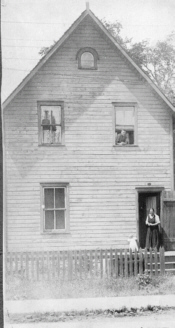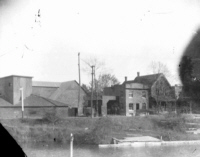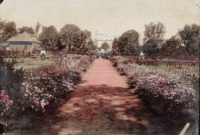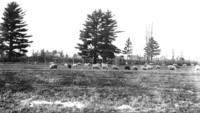|
|
|
|
| And just a few meters south on Main was Ardagh Square, the
family home of the Grahams. The late John Graham owned hotels in Ottawa
(The Albion) and the brickyard at the end of Clegg St. These families were,
for the most part, the most influential in the village and all lived within
a short distance of the town hall. |
| Immediately to the north of this center point was a nearly
impenetrable barrier - J. R. Booth's Grand Trunk Railroad. These tracks
sliced the community into three separate parts, much as the Queensway does
today. From Hurdman Bridge to the canal there was only one official crossing
- at Main. Given the large amount of traffic on this GTR line at this point,
a flagman and kiosk was installed to assist traffic and pedestrians. Purdy
was the flagman at this time and photographs show a pleasant plump man in
his sixties surrounded always by kids. To village children, Purdy's little
house was the center of the universe. |
|
|
|
|
|
|
|
|
|
The village council had tried for years to force Booth to build a proper
crossing at the end of William St (Lees) so as to allow unhindered travel
to the north-eastern part of the village (Robinson Ave.). As one of the
richest men in Canada, Booth was a formidable adversary. As the story
goes, he built the Ottawa East rail line next the Lees property to destroy
the quiet and isolation of Wildwood. Whatever his reason, after he built
the line in 1882, he and Robert Lees battled ever after.
|
| |
Without the crossing on William, the tiny enclave centered
on Robinson Ave. was virtually cut off. That  isolation
continued up to the end of the Twentieth Century when better roads and bridges
were built. Even today (2004) residents of this area still identify more
with Sandy Hill that Ottawa East. The rail lines were also the very reason
the village existed. About 20% of the employed adult males in the village
worked for the railways, in particular the Canada Atlantic. Most of the
village industry was completely dependent on rail transport as it brought
the coal and vast quantities of raw and finished wood and shipped out the
bricks. Further isolating Robinson Ave. was the vast array of lumber and
coals sheds and stack of wood along the tracks. The only commercial activity
in the area other than this was the slaughterhouse at the end of the street
on the bank of the Rideau River. The river was the key here. Think of all
the entrails that daily emanates from an abattoir and then wonder where
this material was dumped! isolation
continued up to the end of the Twentieth Century when better roads and bridges
were built. Even today (2004) residents of this area still identify more
with Sandy Hill that Ottawa East. The rail lines were also the very reason
the village existed. About 20% of the employed adult males in the village
worked for the railways, in particular the Canada Atlantic. Most of the
village industry was completely dependent on rail transport as it brought
the coal and vast quantities of raw and finished wood and shipped out the
bricks. Further isolating Robinson Ave. was the vast array of lumber and
coals sheds and stack of wood along the tracks. The only commercial activity
in the area other than this was the slaughterhouse at the end of the street
on the bank of the Rideau River. The river was the key here. Think of all
the entrails that daily emanates from an abattoir and then wonder where
this material was dumped! |
| The Fire Insurance Maps here show the isolation of this community
by the rail lines and lumber sheds |
|
|
|
|
From this point southwest to the "Deep Cut" where the canal
takes a sharp left-hand turn, was the "round house" complex.
This was huge circular building in the center of which was a turntable
that allowed engines to be turned and directed in to repair slots. This
area employed hundreds of people who repaired and serviced the equipment
as well as shunting a never-ending amount of coal, wood and a myriad of
other material around the rail yard. There is much more on the railway's
activities here.
 The
triangle formed between the rail complex and the canal was diverse. Amidst
the piles of finished lumber and warehouses along the canal bank were
residences of some of the oldest residents of the village. For the most
part these were the descendants of the "squatters" who had fought
the Dominion Government for decades over the right to own the property.
Large businesses such as Ballantyne Coal maintained sheds next to the
rail line. There were even a hotels: The Atlantic, owned and operated
by Joseph Landriau; and The Beaver, owned and operated by Isaac Biggars.
Both were on the south side of East Avenue near Centre St. (Concord).
These establishment served the farmers and businessmen travelling along
the canal to the market in Ottawa. Blurry photographic evidence suggests
that the buildings had about 10 rooms. The
triangle formed between the rail complex and the canal was diverse. Amidst
the piles of finished lumber and warehouses along the canal bank were
residences of some of the oldest residents of the village. For the most
part these were the descendants of the "squatters" who had fought
the Dominion Government for decades over the right to own the property.
Large businesses such as Ballantyne Coal maintained sheds next to the
rail line. There were even a hotels: The Atlantic, owned and operated
by Joseph Landriau; and The Beaver, owned and operated by Isaac Biggars.
Both were on the south side of East Avenue near Centre St. (Concord).
These establishment served the farmers and businessmen travelling along
the canal to the market in Ottawa. Blurry photographic evidence suggests
that the buildings had about 10 rooms.
|
|
The triangle had the only church and the only school. Trinity Anglican
(later Ascension) was utilised by most  Christian
denominations in the village at this point. School children from as far
south as Clegg St. daily crossed the tracks at Main. That's why most kids
knew Mr. Purdy. The school itself was nestled at the notch of Centre St.
(Concord North) and Fifth (Harvey), right next to the rumbling railroad
and backed by a swamp that extended from the Deep Cut to the railway.
It must have been an experience for a youngster to use the school outhouse
on a hot humid Ottawa day deluged by swarms of mosquitoes and black flies.
That was Ottawa East around 1901. Christian
denominations in the village at this point. School children from as far
south as Clegg St. daily crossed the tracks at Main. That's why most kids
knew Mr. Purdy. The school itself was nestled at the notch of Centre St.
(Concord North) and Fifth (Harvey), right next to the rumbling railroad
and backed by a swamp that extended from the Deep Cut to the railway.
It must have been an experience for a youngster to use the school outhouse
on a hot humid Ottawa day deluged by swarms of mosquitoes and black flies.
That was Ottawa East around 1901.
 Archibald
Stewart (founder of Archville) had donated the school land, probably because
he couldn't sell the location given the swamp and railroad. The Education
Department inspector had condemned the building itself the year before
and there was a flurry of village council activity in 1901 to pass a debenture
bylaw for a new school. Archibald
Stewart (founder of Archville) had donated the school land, probably because
he couldn't sell the location given the swamp and railroad. The Education
Department inspector had condemned the building itself the year before
and there was a flurry of village council activity in 1901 to pass a debenture
bylaw for a new school.
|
The only bridge connection to Ottawa was located at Cedar
St. (Harvey projected) across the canal to Argyle Ave. at Cartier. Built in 1890, this iron and wood swing bridge provided
the need access to city markets and jobs. It however, could not manage heavy
traffic such as wagons loaded with brick or the new trolley that came to
the end of Elgin St. Ottawa Easters still had to trudge across in subzero
weather to access public transport. A portion of the bridge
Argyle Ave. at Cartier. Built in 1890, this iron and wood swing bridge provided
the need access to city markets and jobs. It however, could not manage heavy
traffic such as wagons loaded with brick or the new trolley that came to
the end of Elgin St. Ottawa Easters still had to trudge across in subzero
weather to access public transport. A portion of the bridge
can be seen here on the Fire Insurance Map. |
| Across Seventh St. (Hawthorne), along the bank
of the canal, the diversity continued. The waterway was used by numerous
pleasure craft (mostly row boats and canoes) and provided numerous transshipment
points for everything from sand to coal to wood. W. E. Beaton, a leader
of the Baptist Church, village councillor and merchant, operated a wood-fuel
yard at Clegg and the canal.
|
| Patterson's field was the largest garden plot
between the canal and Main (later St. Pat's College and then Immaculata).
The streets between Gordon (Hazel) and Clegg continued to draw new residents,
most of who built their own homes. |
| Across Main from Seventh (Hawthorne) to Victoria (Springhurst)
it was mostly residential interspersed with local businesses. The major
industry was the O'Dell brickyard located at the end of William St. (Lees)
approximately where Simcoe St. is today. Horace O'Dell made extensive use
of the sand and clay deposits along the Rideau River at Springhurst. A rail
spur was built from the CPR line directly into his factory. |
Adjacent and south was the Scholasticate (Deschâtelets),
the center of the Oblates of Mary Immaculate  (OMI).
This was a sprawling complex of about 30 acres, set far back from Main St.
For the most part it was separate from village life in that the Oblates
were self-contained with their own extensive vegetable gardens, livestock
and poultry supplies. But they were also the leaders of the Catholic community
and played the major role in the establishment of the Ste. Famille parish
and Catholic schools. There is much more on this complex story found
here. (OMI).
This was a sprawling complex of about 30 acres, set far back from Main St.
For the most part it was separate from village life in that the Oblates
were self-contained with their own extensive vegetable gardens, livestock
and poultry supplies. But they were also the leaders of the Catholic community
and played the major role in the establishment of the Ste. Famille parish
and Catholic schools. There is much more on this complex story found
here. |
|
South of the Oblates were the extensive farms of the Williams and Slattery
families and the Graham Brickyard at the river end of Clegg St. The Williams family owned about 50 acres
of prime land to the west of Main St. between Riverdale and the Rideau
River. This later became Rideau Garden (not Gardens!). Slattery had extensive
pastures on both sides of Main for his large beef cattle and sheep herds
that he regularly drove up Main to the markets in Ottawa. The profits
from his butcher business made him one of the richest and most powerful
men in the village and the region. More on his story can be found
here.
at the river end of Clegg St. The Williams family owned about 50 acres
of prime land to the west of Main St. between Riverdale and the Rideau
River. This later became Rideau Garden (not Gardens!). Slattery had extensive
pastures on both sides of Main for his large beef cattle and sheep herds
that he regularly drove up Main to the markets in Ottawa. The profits
from his butcher business made him one of the richest and most powerful
men in the village and the region. More on his story can be found
here.
That was the 1901 setting of the village - few major industries, a railway
complex, inexpensive housing and lots of agriculture. It was the people
who made it work.
|
| |
 Return to 1901 Snapshot Page One
Return to 1901 Snapshot Page One |
|


 Argyle Ave. at Cartier. Built in 1890, this iron and wood swing bridge provided
the need access to city markets and jobs. It however, could not manage heavy
traffic such as wagons loaded with brick or the new trolley that came to
the end of Elgin St. Ottawa Easters still had to trudge across in subzero
weather to access public transport. A portion of the bridge
Argyle Ave. at Cartier. Built in 1890, this iron and wood swing bridge provided
the need access to city markets and jobs. It however, could not manage heavy
traffic such as wagons loaded with brick or the new trolley that came to
the end of Elgin St. Ottawa Easters still had to trudge across in subzero
weather to access public transport. A portion of the bridge  (OMI).
This was a sprawling complex of about 30 acres, set far back from Main St.
For the most part it was separate from village life in that the Oblates
were self-contained with their own extensive vegetable gardens, livestock
and poultry supplies. But they were also the leaders of the Catholic community
and played the major role in the establishment of the Ste. Famille parish
and Catholic schools. There is much more on this complex story found
here.
(OMI).
This was a sprawling complex of about 30 acres, set far back from Main St.
For the most part it was separate from village life in that the Oblates
were self-contained with their own extensive vegetable gardens, livestock
and poultry supplies. But they were also the leaders of the Catholic community
and played the major role in the establishment of the Ste. Famille parish
and Catholic schools. There is much more on this complex story found
here.